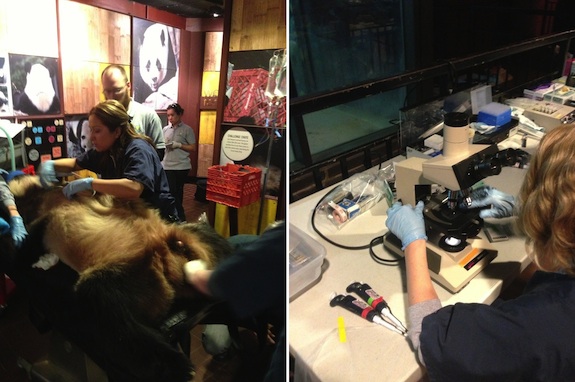Video: Panda Gets Randy, Keeper Reports on the Panda-monium
Breeding season for the giant pandas gets underway this month at the National Zoo

Mei Xiang (left) and Tian Tian are in their breeding season. All photos courtesy of the National Zoo
As the annual breeding season for the National Zoo’s giant pandas gets under way this month, keeper Juan Rodriguez promises to keep us updated with eye-witness reports from behind-the-scenes. Mei Xiang’s and Tian Tian’s behavior has been changing over the past few weeks and the Zoo estimates that breeding will most likely occur between mid-March and mid-April. The animals normally maintain a fairly low-key lifestyle, spending most of their time chill-axing and eating the bamboo, which is their main fare. But as Zoo officials monitor Mei Xiang’s hormone levels to determine if she is in estrus, she has also become much more energetic in her activities. Visitors are highly unlikely to catch a scene like this, but keeper Rodriguez used his cell phone to capture raw footage when she climbed up a tree and did a little “happy dance.”
February 12, 2013
Today Tian Tian underwent a short medical procedure, in which veterinary staff pulse a gland that is similar to the prostate to induce ejaculation in order to collect and preserve his semen. Semen preservation is essential for animal management and especially for critically endangered species. It is yet another tool in the conservation arsenal that is being used to stave off the extinction of species and to promote good genetic health of population. Unfortunately, we were not successful at collecting viable sperm samples. Having animals under anesthesia always presents some challenges, one of these challenges is that it can have a negative affect on the samples produced. In our case, urine had contaminated the sample. Perhaps, we may try again later this season. Since pandas only breed once per year, the males do not produce sperm year round, so capture is important for about three to four months out of the year. Hopefully we’ll have better luck next time.
February 23, 2013
This morning Mei Xiang was being very feisty and rambunctious, spending more time than normal at the back of the yard where I was cleaning her stall. So I decided to aim the hose out toward the ground where she was and she immediately began to play with the water stream and in the process soaked me to the bone. After playing with the water stream for about one minute, she then ran off to her favorite ginkgo tree, climbed up and started rubbing on it—which is her way of marking it with her scent. This behavior is a good sign that it is the prelude to the breeding season as this is a way for her to leave her calling card for the male. Let’s keep our fingers crossed that she goes into her breeding stage soon. I didn’t have a good camera with me, so pulled out my cell phone to capture the scene.
February 24, 2013
Who said you can’t teach and old dog new tricks? Today was Tian Tian’s first day to demonstrate his new skill. He finally learned to offer his right arm (instead of his left) so that veterinary staff can draw blood for routine check ups. This is an important breakthrough because now the vets and medical staff have the option of using either arm. Just like humans, all animals have better veins in one arm than in the other.
February 27, 2013
This week has marked a unique stage in the pandas’ eating behavior. Up until now, they had been consuming both the stalk and the leaves of the bamboo. Now, they are eating stalk exclusively. In the summer they eat almost exclusively the bamboo leaves and no stalk at all. It as if the pandas know what portion of the bamboo they need to eat to moderated their own metabolic and caloric needs. To the human eye most bamboo species look very similar, but to a pandas’ nose they can tell if it’s nutritious or not. Today I pulled out some bamboo that looked beautiful on the outside: shinny green stalk and fresh juicy leaves, but when I was tidying up, I found a discarded piece and I could see where Tian Tian had bitten into the middle of the stalk. When I examined the inner lining of the stalk (also known as the culm), the color was dark and didn’t smell fresh. The panda knows best.
